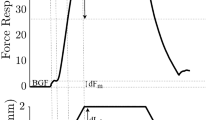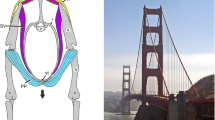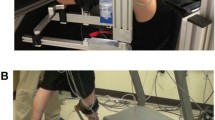Abstract
The cat hindlimb muscles have been classified, traditionally, as flexors and extensors, based on their actions in the parasagittal plane and their patterns of recruitment during locomotion and reflex responses. This study provides a detailed examination of the relative magnitudes of the various moment arms of the cat ankle muscles and the interdependent effects of position in the various axes of motion. We used a method based on observing small sliding movements of tendon in response to small angular displacements of the joint. Surprisingly, we found that the ankle joint of the cat permits substantial motion in three axes (eversion/inversion and abduction/ adduction as well as extension/flexion) and many muscles crossing the ankle joint have their largest moment arms about axes other than extension/flexion. These moment arms often depended on the joint position in the axis of the moment arm and, to a lesser degree, on the extension/ flexion angle as well. For some muscles (notably peroneus longus) there was sufficient variability that the predominant action in neutral posture (axis with the largest moment arm) could change from animal to animal, which may be related to heterogeneities of locomotor and reflex recruitment reported in the companion paper.
Similar content being viewed by others
References
Abraham LD, Loeb GE (1985) The distal hindlimb musculature of the cat. Patterns of normal use. Exp Brain Res 58:580–593
Abraham LD, Marks WB, Loeb GE (1985) The distal hindlimb musculature of the cat. Cutaneous reflexes during locomotion. Exp Brain Res 58:594–603
An KN, Ueba Y, Chao EY, Cooney WP, Linscheid RL (1983) Tendon excursion and moment arm of index finger muscles. J Biomech 16:419–425
An KN, Takahashi K, Harrigan TP, Chao EY (1984) Determination of muscle orientations and moment arms. J Biomech Eng 106:280–282
Crouch JE (1969) Text-atlas of cat anatomy. Lea and Febiger, Philadelphia
Gans C, Bock WJ (1965) The functional significance of muscle architecture — a theoretical analysis. Ergeb Anat Entwicklungsgesch 38:116–141
Gans C, Gaunt AS (1991) Muscle architecture in relation to function. J Biomech 24:53–65
Goslow GE Jr, Reinking RM, Stuart DG (1973b) Physiological extent, range and rate of muscle stretch for soleus, medial gastrocnemius and tibialis anterior in the cat. Pflugers Arch 344:77–86
Goslow GE Jr, Cameron WE, Stuart DG (1977) Ankle flexor muscles in the cat: length-active tension and muscle unit properties as related to locomotion. J Morphol 153:23–38
Griffiths RI (1987) Ultrasound transit time gives direct measurement of muscle fibre length in vivo. J Neurosci Methods 21:159–165
Hoffer JA, Caputi AA, Pose IE, Griffiths RI (1989) Roles of muscle activity and load on the relationship between muscle spindle length and whole muscle length in the freely walking cat. Prog Brain Res 80:75–85
Hoy MG, Zernicke RF (1986) The role of intersegmental dynamics during rapid limb oscillations. J Biomech 19:867–877
Levens AS, Inman VT, Blosser JA (1948) Transverse rotation of the segments of the lower extremity in locomotion. J Bone Joint Surg 30:859–872
Loeb GE (1993) The distal hindlimb musculature of the cat: interanimal variability of locomotor activity and cutaneous reflexes. Exp Brain Res 96:125–140
Macpherson J (1988a) Strategies that simplify the control of quadrupedal stance. I. Forces at the ground. J Neurophysiol 60:204–217
Macpherson J (1988b) Strategies that simplify the control of quadrupedal stance. II. Electromyographic activity. J Neurophysiol 60:218–231
Nichols TR (1989) The organization of heterogenic reflexes among muscles crossing the ankle joint in the decerebrate cat. J Physiol (Lond) 410:463–477
O'Donovan MJ, Pinter MJ, Dum RP, Burke RE (1982) Actions of FDL and FHL muscles in intact cats: functional dissociation between anatomical synergists. J Neurophysiol 47:1126–1143
O'Donovan MJ, Pinter MJ, Dum RP, Burke RE (1985) Kinesiological studies of self- and cross-reinnervated FDL and soleus muscles in freely moving cats. J Neurophysiol 54:852–866
Otten E (1987) Optimal design of vertebrate and insect sarcomeres. J Morphol 191:49–62
Sacks RD, Roy RR (1982) Architecture of the hind limb muscles of cats: functional significance. J Morphol 173:185–195
Smidt G (1973) Biomechanical analysis of knee flexion and extension. J Biomech 6:79–92
Smith JL, Betts B, Edgerton VR, Zernicke RF (1980) Rapid ankle extension during paw shakes: selective recruitment of fast ankle extensors. J Neurophysiol 43:612–620
Soudan K, Van Audekercke R, Martnes M (1979) Methods, difficulties and inaccuracies in the study of human joint kinematics and pathokinematics by the instant axis concept. Example: the knee joint. J Biomech 12:27–33
Spoor CW, Van Leeuwen JL (1992) Knee muscle moment arms from MRI and from tendon travel. J Biomech 25:201–206
Spoor CW, Van Leeuwen JL, Mesker CG, Titulear AF, Huson A (1990) Estimation instantaneous momenl arms of lower-leg muscles. J Biomech 23:1247–1259
Young RP, Scott SH, Loeb GE (1992) Joint-angle-dependent moment arms of feline ankle muscles. An instrinsic mechanism to stabilize posture. Neurosci Lett 145:137–140
Author information
Authors and Affiliations
Rights and permissions
About this article
Cite this article
Young, R.P., Scott, S.H. & Loeb, G.E. The distal hindlimb musculature of the cat: multiaxis moment arms at the ankle joint. Exp Brain Res 96, 141–151 (1993). https://doi.org/10.1007/BF00230447
Received:
Accepted:
Published:
Issue Date:
DOI: https://doi.org/10.1007/BF00230447




